Salwar kameez
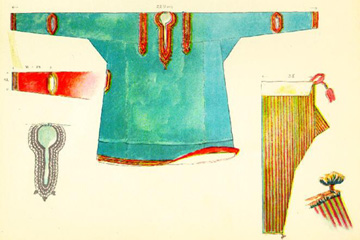
Shalwar kameez (also spelt shalwar kameez or shalwar qameez), Urdu: شلوار قمیض is the dress worn by both women and men in northern South Asia and Central Asia. It is a unisex dress similar in manner to shirt and pants worn by both women and men in the west. Traditionally, it has been worn in Afghanistan and Punjab (Pakistan and northern India). From the last century, women in southern India have copied this Punjabi dress in place of the sari, the traditional dress of India. Shalwar or salwar (as pronounced in India) are loose pajama-like trousers. The legs are wide at the top, and narrow at the ankle. The kamees is a long shirt or tunic. The side seams (known as the chaak), left open below the waist-line, give the wearer greater freedom of movement.
Contents |
Description

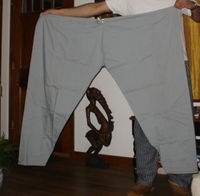
Shalwar are gathered at the waist and held up by a drawstring or an elastic band. The pants can be wide and baggy or more narrow, and even made of fabric cut on the bias.
The kameez is usually cut straight and flat; older kamees use traditional cuts, as shown in the illustration above. Modern kamees are more likely to have European-inspired set-in sleeves. The neckline, sleeves and bottom edge (daaman) are many times decorated with embroidery or laces.
For women, an integral part of shalwar kamees is the dupatta — a long shawl wrapped around body or to cover head in more conservative families. The shalwar kamees fashion has revolved around the cuts and lengths of shalwar and of kamees and the print styles and color palette of the dupatta.
As this dress was introduced to India through the Punjabis from its western origins, it is commonly referred to as Punjabi suit by Punjabis and Indians in general. In Britain, especially during the last two decades, the garment has been transformed from an everyday garment worn by immigrant South Asian women from the North-West Frontier Province, Balochistan, Sindh, Kashmir and Punjab regions to one with mainstream, and even high-fashion, appeal.[1]
In India, the garment was originally confined to the North as a convenient and modest alternative to a sari — and as one that flatters practically any body type. It has become popular across the nation. By varying the fabric, color and the level of embroidery and decoration, the salwar kameez can be formal, casual, dressy, or plain; it can be made to suit practically all climates.
Etymology and history
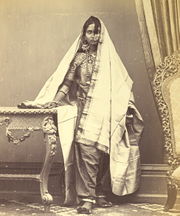
Portrait of a Muslim girl from Karachi, Sind, in a salwar and blouse. c. 1870. Oriental and India Office Collection, British Library.
|
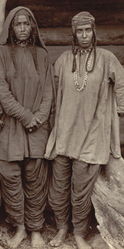
Hill women, Kashmir, in salwar-kameez. c. 1890.
|
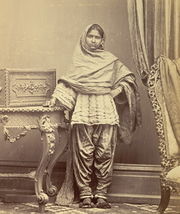
Portrait of a Hindu girl from Karachi, Sind, in narrow salwar & kameez. c. 1870. Oriental and India Office Collection, British Library.
|
Garments cut like the traditional kameez are known in many cultures; according to Dorothy Burnham, of the Royal Ontario Museum, the "seamless shirt," woven in one piece on warp-weighted looms, was superseded in early Roman times by cloth woven on vertical looms and carefully pieced so as not to waste any cloth. 10th century cotton shirts recovered from the Egyptian desert are cut much like the traditional kameez or the contemporary Egyptian jellabah or galabia.[2]
Salwar kameez dates back to the 12th century, the Islamic or the Iranian era, which was then followed by the Mughal empire in the region now called Punjab.
The pants, or shalawar, are known as shalvaar qameez Urdu: شلوار قمیض in Urdu, salvaar or shalvaar शलवार क़मीज़ in Hindi, salvar in Punjabi: ਸਲਵਾਰ ਕ਼ਮੀਜ਼ and salvaar or shalvaar શલવાર કમીઝ in Gujarati. The word comes from the Persian: شلوار, meaning pants.
The shirt, kameez or qamiz, takes its name from the Arabic qamis. There are two main hypotheses regarding the origin of the Arabic word, namely:
- that Arabic qamis is derived from the Latin camisia (shirt), which in its turn comes from the Proto-Indo-European kem (‘cloak’).[3]
- that Mediaeval Latin camisia is a borrowing through Hellenistic Greek kamision from the Central Semitic root “qmṣ”, represented by Ugaritic qmṣ (‘garment’) and Arabic qamīṣ (‘shirt’).
English spelling
Transliterations starting from Urdu, Persian, Pashto and Turkish languages use "sh". Both spellings are found in common English usage. Transliterations starting from Punjabi often render the sibilant sound at the start of salwar/shalwar as an "s". The shalwar spelling seems to be most common in Canada and the United Kingdom, and is the preferred spelling in the Oxford English Dictionary. Salwar seems to be more common in the US and is found at many online stores selling salwar kameez. The word kameez is often incorrectly spelled with an H, as in khameez.
Gallery
 Punjabi actress Kareena Kapoor in a Salwar Kameez at a function |
 Woman wearing a churidar and kameez |
 A man wearing a cap and salwar kameez. |
|
 Woman in green cotton salwar kameez. |
See also
References
- ↑ Bachu 2004
- ↑ Burnham, Dorothy. 1973. Cut My Cote, Royal Ontario Museum. p. 10.
- ↑ "Online Etymology Dictionary: chemise". http://www.etymonline.com/index.php?term=chemise.
External links
|
|||||||||||